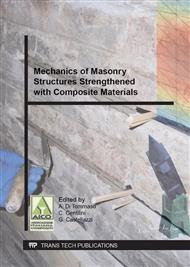[1]
Guerra E. P., Risanamento di murature umide e degradata. Sintomi e cause – Rimedi – Soluzioni progettuali. Dario Flaccovio Editore s. r. l. (2011), 336 pp.
Google Scholar
[2]
Borrelli E., Porosity, in Conservation of Architectural Heritage, Historic Structures and Materials ARC Laboratory Handbbok vol. 2, ICCROM, Atel spa, Rome (1999), 20 pp.
Google Scholar
[3]
Coppola, L., Collepardi, M., Il ruolo dell'umidità nel degrado dei materiali nelle murature, Il nuovo Cantiere, vol. 6 (1996), 44-51.
Google Scholar
[4]
Binda, L, Charola AE, Baronio, G. Deterioration of porous materials due to salt crystallisation under different thermohygrometric conditions. Proc. of 5th Int. Conf. on deterioration and conservation of stone, vol. I, Lausanne, Suisse, 1985, 279–288.
Google Scholar
[5]
Scherer, G.W. Stress from crystallization of salt, Cement and Concrete research 34, (2004) 1613-1624.
DOI: 10.1016/j.cemconres.2003.12.034
Google Scholar
[6]
Collepardi, M., Collepardi, S., Troli, R. Salt weathering of masonry walls the Venice experiences", Proc. of CANMET/ACI Int. Conf., Salonicco, Greece, June 2003, pp.
Google Scholar
[7]
Colla, C., Gabrielli, E., Largo, A., Angiuli, R. Experimental studies by combined NDT of capillary rise monitoring in masonry specimens", Proc. of EWCHP-2011, European Workshop on Cultural Heritage Preservation, Berlin, Germany, September 26-28, 2011, 131-139.
Google Scholar
[8]
Colla, C., Forde M.C., McCann, D., Das, P.C. Investigation of masonry arch bridges using non-contacting NDT, Proc. VI Int. Conf. Structural Faults and Repair-'95, Engineering Technics Press, Westminster Central Hall, London, 3-5 July, 1995, vol. 1, 235-239.
Google Scholar
[9]
Colla, C., Gruener, F., Gabrielli, E., Frick, J. Monitoring of salt content and mobility in masonry materials, Proc. of EWCHP-2011, European Workshop on Cultural Heritage Preservation, Berlin, Germany, September 26-28, 2011, 210-217.
Google Scholar
[10]
Colla, C., McCann, D., Forde, M.C. Radar testing of a masonry composite structure with sand and water backfill, ASCE Bridge Engineering J., vol. 6, (4), (2001), 262-270.
DOI: 10.1061/(asce)1084-0702(2001)6:4(262)
Google Scholar
[11]
Frick, J., Colla, C., Gabrielli, E., Gruener, F. Seasonal Monitoring of Salt Movement in Masonry Materials, Proc. of EWCHP 2012, 2nd European Workshop on Cultural Heritage Preservation, Kjeller, Norway, 24th -26th September, 2012, 27-34.
Google Scholar
[12]
Frick, J., Gabrielli, E., Colla, C., Gruener, F. Long-term Monitoring of Salt Movement in Masonry Materials, 9th International Masonry Conference, 7-9 July, 2014, Guimarães, Portugal (accepted).
Google Scholar


